- Introduction -
Below a picture is shown with an M4A4 Sherman tank in a
'Duplex-Drive' (DD) disguise. Surrounded by a canvas skirt, the tanks
‘hung’ as it where in this skirt. These tanks would be launched far out in
the sea, and were driven forward by two propellers at the rear.
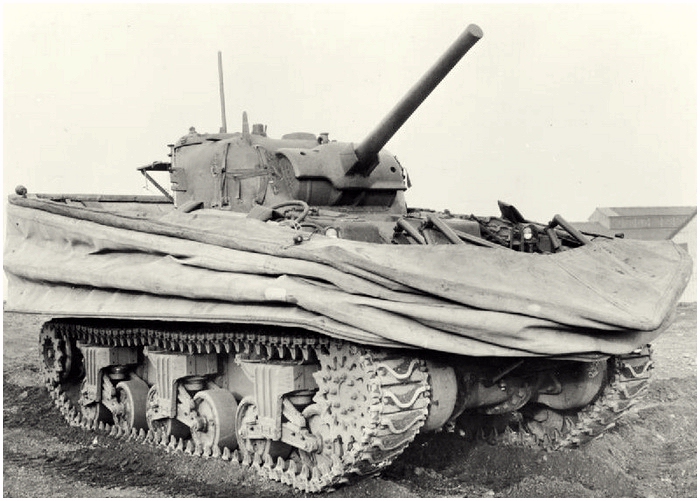
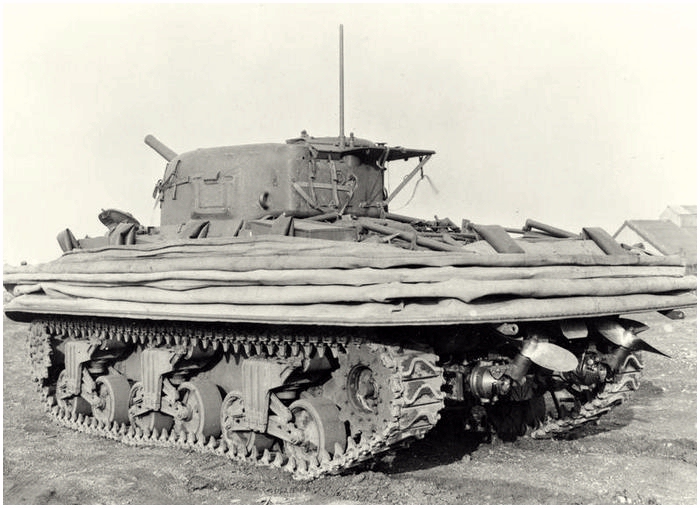
With only a small portion of the canvas skirt above the waves,
the tanks would suddenly pop out of the water, onto the beach and
surprise the enemy. The British and the Canadian troops used only
the M4A2 and the M4A4 for the DD version. The Americans used for
the DD version the M4 and the M4A1, and only the latter version for
the landings on the Normandy beaches on June 6, 1944. And with the
last one, the M4A1 version, was something strange which
would keep me busy for years,….
- Omaha Beach -
The 'Duplex-Drive' (DD) tanks would be launched from LCT’s at 6000 yards
(5500 meter), when the sea was not TOO rough. Every LCT had four DD tanks on board.
But despite that the sea was very rough, some LCT launched the DD’s early. After the
war some DD’s were located at 9000 yards from the coast. Of the 32 launched DD tanks
from the 741st Tank Battalion, only two would reach the beach, in the left sector, by
‘swimming’. Three other DD tanks were brought in by LCT-600.
After the first DD drove from the ramp of LCT-600, and sunk before the
eyes of the crew of the LCT, on board of the LCT-600 the order was given to bring the
tanks closer to shore. The second tank, ready to launch, drove a bit back and damaged
the canvas skirt, or the part of the ramp (sources differ). Now the order changed again,
to bring the tanks on to the beach.
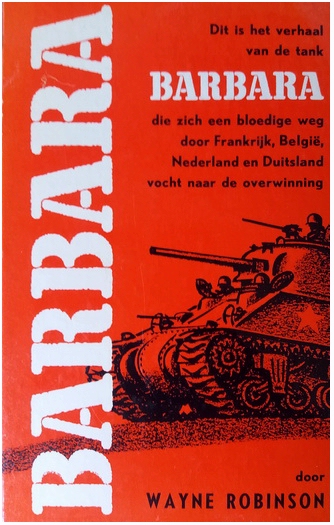
The DD tanks of the 743rd Battalion on the right flank of Omaha Beach were
brought by the LCT’s all the way to the beach, although some were launched
close to it (some of the last became trapped in the obstacles under the
waterline). When these tanks rolled onto the beach near Vierville-sur-Mer,
they became sitting ducks for the German guns.
Left: Now a
collector’s item, the book ‘Barbara’
(also known as
'Hell has no Heroes')
In the book 'Barbara' by Wayne Robinson we follow a Sherman tank,
in 'Duplex-Drive' (DD) disguise, and her crew. The story around the M4 Barbara is fiction, but the events
did happen for real. She landed during the first wave on Omaha Beach. I have in my possession
only the Dutch translation (from 1965) and this has some flaws in it. The 'mistakes' can get a reader,
who knows its subject, off. The writer mentions that the M4A1 Sherman had a
'Wright Cyclone' engine (the basis for the American DD version), but they had infact the Wright Continental R-975.
Also, there is no mention of the little platform at the back of the turret from where the commander of the
tank could steer the tank when the canvas skirt was up. But an other one of these ‘flaws’
(as I thought) handles on the ‘ventilation shaft’ on the rear of the tank, something I blamed the Dutch translating.
I translate the next sentence from the Dutch text back to English.
'In her battalion she was tank no.7, second platoon, B squadron.
That number was high on top of her new ventilation shaft , atop of her screws.
The white stood clear and bright against the dull army green paint she was covert with’.
New ventilation shaft; that was a peculiar sentence. From the words Robinson used
it was obvious that he was talking about the DD version, he mentions the propellers/screws and the canvas
skirt. All the pictures I have (and drawings), not one shows a ventilation shaft.
One may think that it was a writers ‘hick-up’, but read the next sentence;
'Grant hoisted his body on top of the tank that would lead the way,
Battle Lady, and stood on top of the engine compartment, between the exhaust chimney
and the turret, to talk to Cavalry Captain Ross.’
I always thought that Robinson used his imagination and was mistaken the DD version on
this ‘shaft-business’ with the version of M4’s with the wading trunks. These Shermans could
maneuver through shallow water and took air, and blew of exhaust through two huge chimneys (or funnels). But,
that someone who served with the 743th Battalion (the first who
dropped there DD-tanks for Omaha in the right sector) was able to make such a mistake?
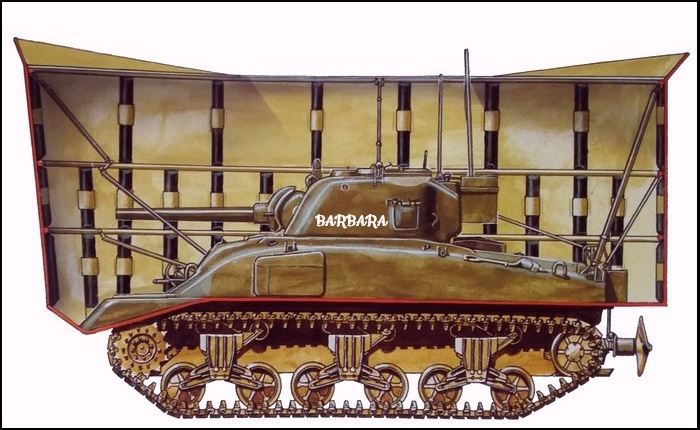 As I pictured the DD tank 'Barbara', some adjusments were needed,...
As I pictured the DD tank 'Barbara', some adjusments were needed,...
On the coming pages, the research will focus on the sectors EASY-Red and FOX-Green
of Omaha Beach. There are more pictures from DD tanks in these sectors, than in the other
sectors of Omaha Beach. And that is peculiar, because much more DD tanks successfully
landed in other sectors than on EASY or FOX, such as on DOG, and survived.
Below; as the M4 version
looked with the wading trunks
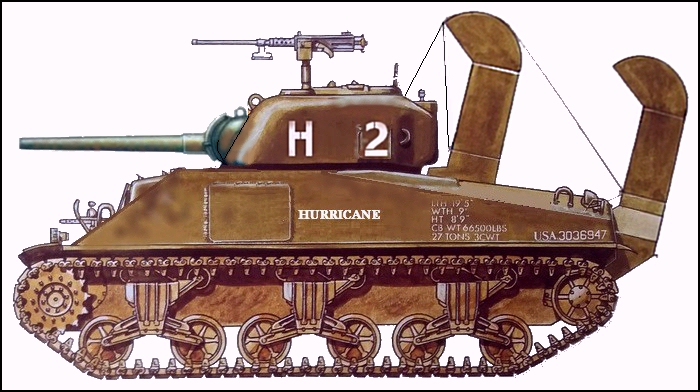 - Easy-Red & Fox-Green -
- Easy-Red & Fox-Green -
Below is a link to the Magnum page where famous photographer Robert Capa worked. Due to copyright I cannot show the photos here. But if you click the link, scroll down to photo #6 and #7 to see the 'chimneys' on the back of the DD tanks.
Enter Robert Capa, click here, the photographer
that went with one of the first waves that landed on Omaha
Beach. According to Capa, these men belong to Easy-Company, 16th Infantry Regiment,
of the 1st Infantry Division, the company where Capa traveled with to the beach.
It is commonly known that the work he shot that day was ruined for a great deal in
a laboratory in England. Only a few survived, and despite there damaged look, or because
of that, they became world famous and are regarded as thé pictures that captured the onslaught
of Omaha Beach at there best. Finally I was able to find one of these pictures in a rather
good state, and what attract my attention,…?
The picture from Capa show some interesting features. The pictures are taken during one of the
first waves. Five minutes before H-Hour, and the first wave, the DD-tanks came ashore.
At H-Hour, around 06.30, the LCT's
went in with the Shermans that could wade to shore (a minute before the infantry would land).
Already can be seen,
on the left, a Sherman with wading trunks, with a large number ‘10’ on the back chimney.
Somewhat to the right of the middle is another wading (or put out of action) ashore. But,
if we enlarge the picture,
two other vehicles can be noticed. These are two DD-tanks with the canvas skirt still up at the
back, but lowered on the front. Even the two little screws are visible at the lower back of the
left DD.
The pictures are taken between EASY-Red and FOX-Green, almost in front of Widerstadnest Wn 62.
The men in the water are from the 16th Infantry Regiment, 1st Infantry Division, probably
from Easy-Compagnie, the unit Capa was with. If you look closely to Capa his pictures, the dark
colored rectangle shape can be seen that is protruding out of the canvas skirt on both of the DD-tanks. Are these the chimneys
Robinson is mentioning?
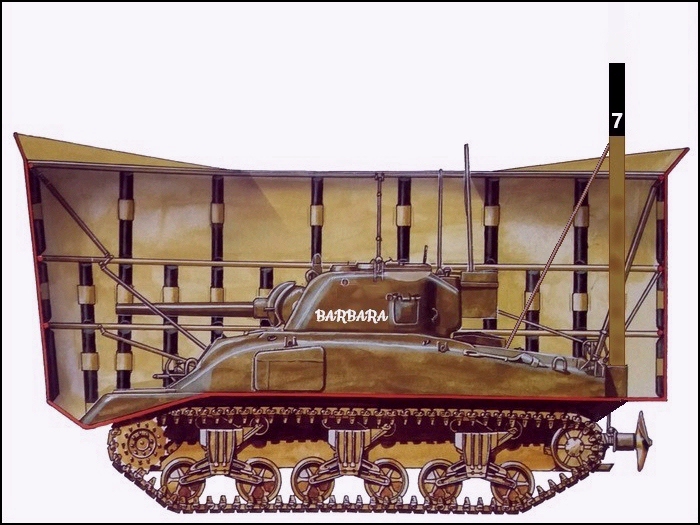 This is an adoptation as seen in the pictures
This is an adoptation as seen in the pictures
These were the only pictures, as far as I knew, of DD-tanks (probably from the 741st Battalion)
where chimneys could be seen. Was this an adaptation only for some type of Sherman tanks,
like the M4A1 version, that had Omaha Beach as there destination?
And so, a search started from 2011,...
with a remarkable surprise at the end,...
On 5 January, 2012 I received a first reaction on this topic from Dave Zollo:
Hi there,
I have recently viewed the thread from 2008 on the ww2 forum whilst looking for reference pictures of deep wading gear
and the question you posed there and on your site about the chimneys on the Omaha DD Shermans. I have a possible
reason or an idea at least as to why, the train of thought started with the comment by 'bodston' that the US DDs
were mainly late large hatch M4A1s.
I have done a lot of research on Shermans recently for a 1/16 rc model build based on one from Band of Brothers
and in part of that I studied a DD recovered a few miles away from me back in the 80s. This DD was lost
in exercise Tiger which was a practise for the Normandy landings and would have
been used on the day on Omaha if it had not been lost at sea, it is a late hull M4A1.
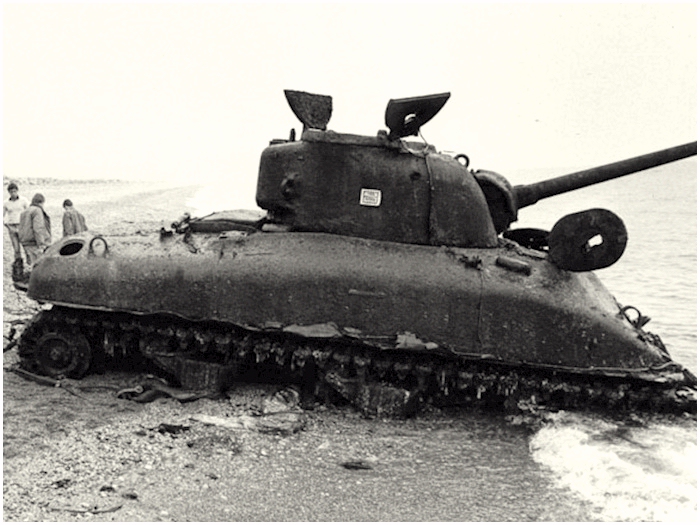 1984, the DD tank is salvaged by Ken Small at Slapton Sands
(Picture:
https://www.thehistorypress.co.uk)
1984, the DD tank is salvaged by Ken Small at Slapton Sands
(Picture:
https://www.thehistorypress.co.uk)
These late hulls have a longer cover over the rear area of the tank where the exhaust pipes are,
this happens to line up with the bottom of the skirt fitting. Therefore there would be no route
for the exhaust gases to escape other than the pipes sticking
in the water so perhaps they fabricated a funnel similar to the deep wading trunks to run under the lower
lip in the armoured rear of the tank and up through the bottom of the skirt and then up near the top of it.
You wouldn't see this funnel on the other model DDs because they didn't need it, and remember a lot of the
American DDs were lost in the channel due to the error in departing them from the ships etc so fewer examples
survived if any.
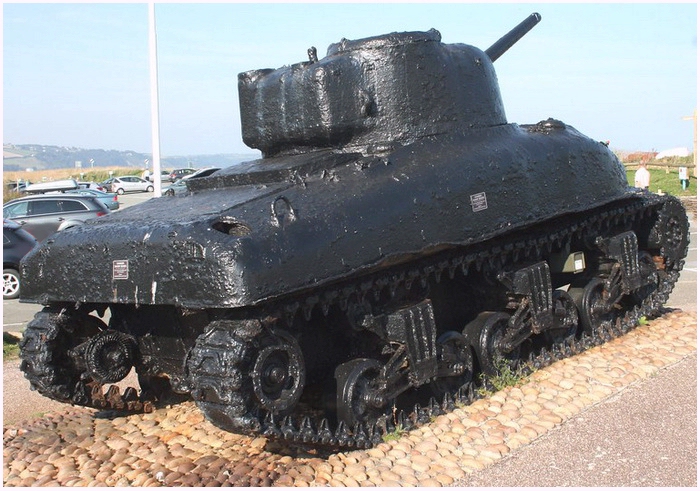 At the rear some evidence where once the propellers were attached
(Picture:
Kingsdude/Dave)
At the rear some evidence where once the propellers were attached
(Picture:
Kingsdude/Dave)
I apologise for my rambling, I had an idea and needed to write it, I hope this in some ways answers your question,
I know it was asked several years ago but perhaps a late answer is better than none.
Thanks for your site and your work on the subject,
Dave
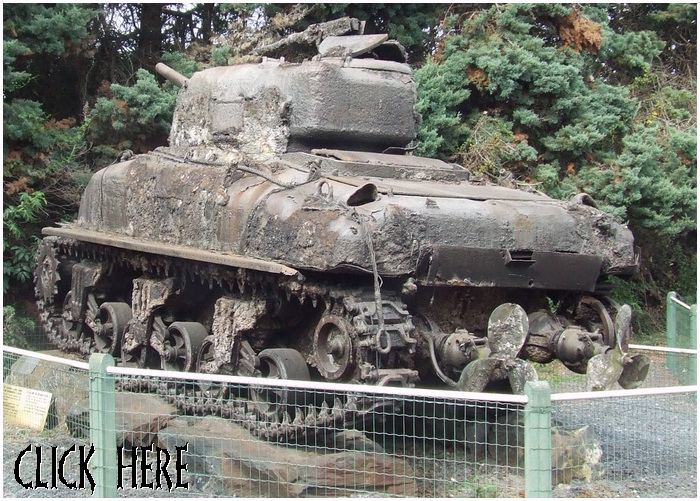 A DD tank at the Musée de Epaves sous-marines de Débarquement
A DD tank at the Musée de Epaves sous-marines de Débarquement
(This Sherman DD was sold in 2018 and shipped to 'Overlord Research LLC',
which houses in West Virginia, United States)
Hi Dave,
Yes it is an old question, but it stil stands. You could have given me the right answer there. It's a pitty that
not a shred of evidence in pictures are to be found or have come to light so far. I can't believe that there has
never been a photo taken of the construction or that a drawing excists of it. I run an article (sorry in Dutch)
on the DD tank: http://www.strijdbewijs.nl/tanks/sherman/m4a1(76)w/actie3.htm
and not a picture shows
pieces of these 'funnel' (and there is a fine one of an M4A1).
If you don't mind, I will post your answer under the article with the pictures of Capa.
And maybe someday a picture will emerge.
Enclosed is a picture of an M4A1 DD tank at the Musée de Epaves sous-marines de Débarquement, near Bayeux.
But also here, no trace of funnel 'debries',... (but I spoke too soon,... see below).
Thanks Dave for your reaction.
With kind regards,
Pieter
 A close up of the rear of the DD tank
A close up of the rear of the DD tank
at the Musée de Epaves sous-marines de Débarquement
(below the 'cargo-tray' and it's position on the M4A1 at Vielsalm, Belgium)
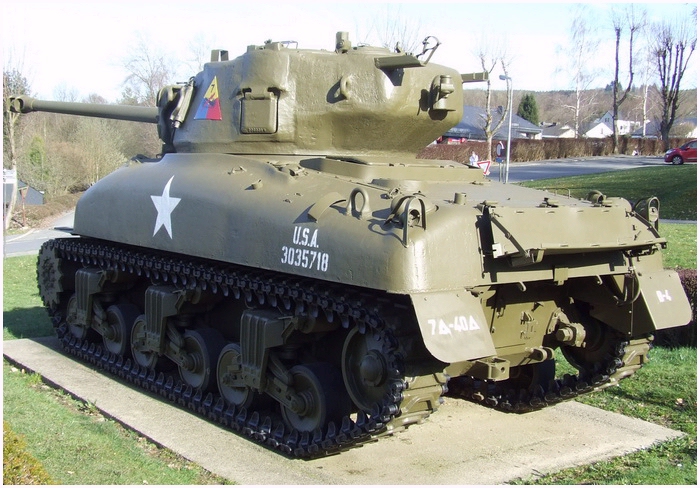
A couple of weeks later, after closer inspection
of another picture of the Sherman at Musée de Epaves sous-marines
de Débarquement, it has the underside of a funnel on
the rear of the Sherman.
My first impression was that the 'plank' on the back was the 'cargo-tray'.
But this tray was placed higher
on the rear of the tank. So, the M4A1 at the Musée de Epaves
sous-marines de Débarquement has pieces left of the exhaust
on the outside, at the rear, of the Sherman.
The first part of the puzzle was solved,
and during the search more and more was revealed,...
On the next page
the search continues
CLICK BELOW
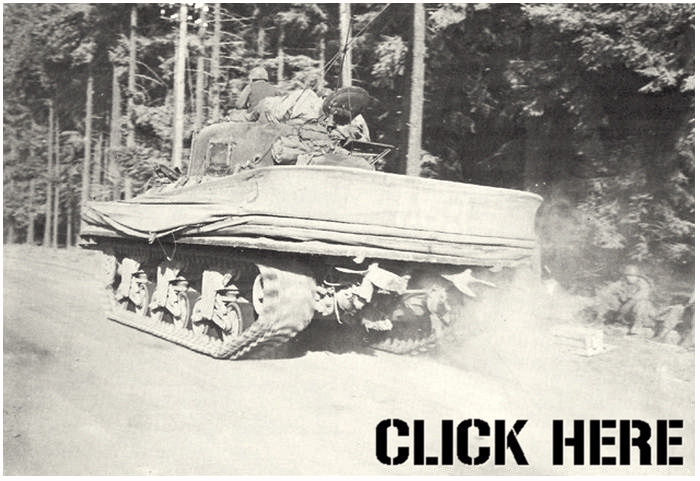
|